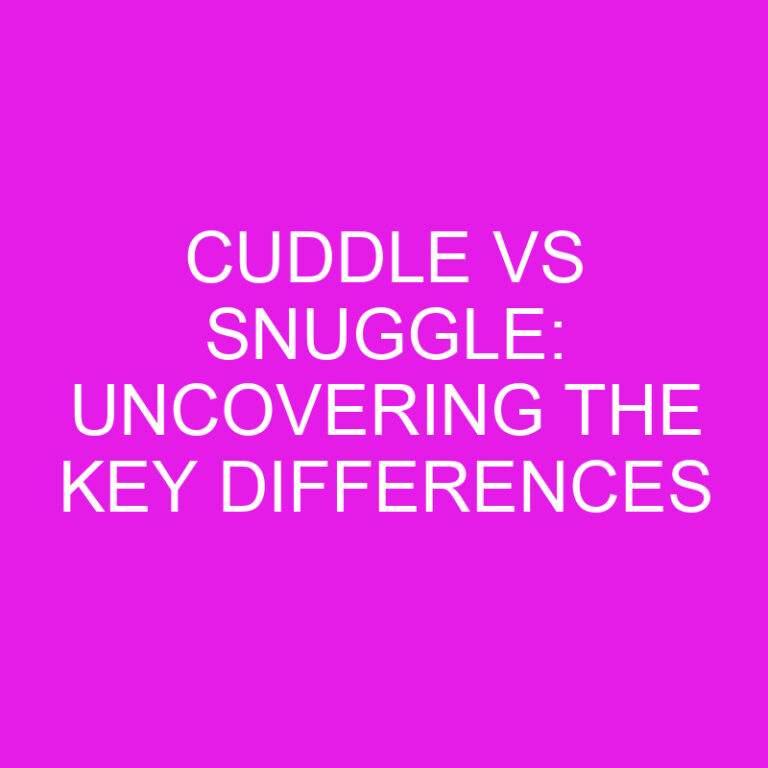
Have you ever wondered about the difference between furlough and layoff? In times of economic uncertainty or unforeseen circumstances, companies often resort to these measures to manage their workforce. While both furlough and layoff involve temporary or permanent separation from work, there are key distinctions between the two. In this article, I’ll explain the nuances of furlough and layoff, helping you understand the impact they have on employees and businesses alike. Whether you’re an employer navigating tough decisions or an employee seeking clarity, read on to gain a deeper understanding of these terms and their implications.
Post Contents
- Key Takeaways
- What is Furlough
- What is Layoff
- Key Differences between Furlough and Layoff
- Impact on Employees
- Impact on Businesses
- Conclusion
- Frequently Asked Questions
- 1. What is the difference between furlough and layoff?
- 2. What are the important distinctions between furlough and layoff?
- 3. What is the impact of furlough on employees?
- 4. What is the impact of layoff on employees?
- 5. How do businesses benefit from furloughs and layoffs?
- 6. What legal considerations do businesses need to navigate when implementing furloughs or conducting layoffs?
Key Takeaways
- Furlough is a temporary leave of absence from work, while a layoff is a permanent separation from work.
- During a furlough, employees may have reduced or suspended working hours and may not receive their full salary, but they remain employed and may be eligible for certain benefits.
- In a layoff, employees are permanently separated from work and may receive a severance package but lose access to benefits.
- Furloughs are usually temporary, while layoffs indicate a permanent separation.
- Furloughs can help companies retain their workforce and mitigate the need for rehiring and training, while layoffs may impact productivity and require resources to rebuild the team.
- Employers must navigate legal obligations and compliance requirements for furloughs and layoffs, including notifying employees and ensuring compliance with benefit and unemployment insurance obligations.
What is Furlough
Furlough is a temporary leave of absence from work that is often used by companies as a cost-saving measure during challenging times. It allows employers to suspend or reduce the working hours of their employees for a predetermined period, while maintaining their employment status.
During a furlough, employees typically do not receive their full salary, or in some cases, any salary at all. However, they are still considered to be employed by the company and may be eligible for benefits such as health insurance, retirement contributions, and unemployment benefits, depending on the policies of the organization and the laws of the country.
Furloughs are usually implemented when a company is facing short-term financial difficulties or when there is a temporary decrease in business activities. By furloughing employees instead of laying them off, companies can retain their workforce and avoid the costs associated with rehiring and training new employees once business improves.
It’s important to note that furloughs are intended to be temporary measures. The duration of a furlough can vary from a few days to several weeks or months, depending on the circumstances. Once the furlough period ends, employees are expected to return to work and resume their normal duties.
During a furlough, employees may be required to adhere to certain conditions or restrictions. This could include limitations on their ability to seek alternative employment or engage in activities that conflict with their employer’s interests. It is crucial for both employers and employees to understand the terms and conditions of the furlough agreement to ensure compliance and a smooth transition back to work. So, while furlough may provide temporary relief during difficult times, it’s important to be prepared for the possibilities that may arise during this period.
What is Layoff
Layoff is a term used to describe a situation where employees are separated from their jobs, usually due to reasons beyond their control. Unlike furloughs, layoffs are usually permanent and involve a complete termination of employment.
When a company implements a layoff, it means that they no longer require the services of certain employees due to various factors such as economic downturn, organizational restructuring, technological advancements, or a decline in business activities.
During a layoff, employees are typically let go without any expectation of returning to work in the future. They may receive a severance package, which is a form of financial compensation provided by the company to assist them during the transition period. This package may include items such as a lump sum payment, extended healthcare benefits, or assistance with job placement services.
Layoffs can be a challenging and unsettling experience for employees as it often involves a sudden loss of income and job security. It is crucial for employers to handle layoffs with sensitivity and transparency, providing employees with clear explanations and support during this difficult time.
It is important to note that during a layoff, employees are usually not eligible for benefits such as health insurance or retirement contributions. Additionally, they may also need to seek alternative employment opportunities to support themselves and their families.
Understanding the difference between furlough and layoff is important for both employers and employees as it determines the rights and responsibilities of each party during periods of economic uncertainty or unforeseen circumstances. By having a clear understanding of these terms, both employers and employees can navigate these challenging situations with greater confidence and clarity.
Key Differences between Furlough and Layoff
When it comes to managing their workforce during times of economic uncertainty or unforeseen circumstances, companies often turn to measures like furloughs and layoffs. While both furloughs and layoffs involve temporary or permanent separation from work, there are key distinctions between the two.
Furloughs are a temporary leave of absence from work that allows employers to suspend or reduce the working hours of their employees for a predetermined period, while maintaining their employment status. During a furlough, employees typically do not receive their full salary, or in some cases, any salary at all. However, they are still considered to be employed by the company and may be eligible for benefits such as health insurance, retirement contributions, and unemployment benefits.
On the other hand, layoffs indicate a permanent separation from work. They occur when a company no longer requires the services of certain employees due to factors such as economic downturn, organizational restructuring, technological advancements, or a decline in business activities. Unlike furloughs, layoffs do not involve an expectation of returning to work in the future.
There are several important differences between furloughs and layoffs:
- Employment Status: During a furlough, employees are still considered employed by the company and may retain certain benefits. However, in the case of layoffs, employees are permanently separated from the company.
- Financial Impact: Furloughed employees often experience a reduction or suspension of their salary, whereas laid-off employees may receive a severance package to assist them during the transition period.
- Eligibility for Benefits: Furloughed employees may still be eligible for certain benefits, such as health insurance and retirement contributions. However, laid-off employees typically lose access to these benefits.
- Duration: Furloughs are usually implemented for a temporary period, ranging from a few days to several weeks or months, depending on the circumstances. Layoffs, on the other hand, indicate a permanent separation from work.
Both furloughs and layoffs can be challenging for both employers and employees. It is crucial for both parties to understand the differences between these measures in order to navigate the rights and responsibilities associated with each during periods of economic uncertainty or unforeseen circumstances. By being well-informed, employers and employees can ensure a smoother transition and make informed decisions regarding their employment. No conclusion paragraph needed.
Impact on Employees
When it comes to the impact on employees, there are some key differences between furlough and layoff that are worth considering. Understanding these differences can help individuals navigate uncertain times and make informed decisions about their employment status. Let’s take a closer look at the impact of each:
Furlough:
- Temporary Leave of Absence: Furloughs are temporary leaves of absence, which means that employees will eventually return to work once the situation stabilizes. This provides some reassurance to workers, as they still have a job to go back to.
- Financial Impact: While on furlough, employees may experience a reduction in working hours or a temporary pay cut. However, they may be eligible for unemployment benefits or other assistance programs during this time.
- Employment Status: Being furloughed does not sever the employment relationship with the company. Employees remain on the payroll and continue to have a connection with their employer, even though they are not currently working.
- Permanent Separation: Unlike furloughs, layoffs indicate a permanent separation from work. This means that employees who are laid off are effectively terminated and no longer have a job to return to.
- Financial Impact: Unlike furloughs, employees who are laid off may face immediate financial challenges. Without a job, they are no longer receiving a salary and may have to rely on savings or government assistance until they find new employment.
- Employment Status: Laid-off employees are no longer connected to the company’s workforce. They do not have a continuing employment relationship and are free to seek opportunities elsewhere.
- Eligibility for Benefits: Depending on the circumstances and the company’s policies, employees who are laid off may be eligible for severance packages, COBRA health insurance coverage, and unemployment benefits.
Understanding these impacts can help employees better navigate the challenges brought on by furloughs or layoffs. Each situation requires careful consideration of one’s financial stability, employment prospects, and available support systems. By staying informed and seeking guidance when needed, individuals can make the best decisions for their own well-being during times of uncertainty.
Impact on Businesses
When it comes to navigating economic uncertainty or unforeseen circumstances, understanding the difference between furlough and layoff is crucial for businesses. Each of these measures carries its own implications and impacts for the organization. Let’s take a closer look at how furloughs and layoffs affect businesses:
- Financial Considerations:
- Furloughs: Implementing furloughs can be a strategic approach for businesses to manage their costs during challenging times. By reducing or suspending the working hours of employees, companies can save on payroll expenses while retaining their valued talent.
- Layoffs: On the other hand, layoffs indicate a more permanent separation from work. When a company decides to lay off employees, it is typically a result of significant financial challenges. This could be due to a downturn in business, the need to restructure, or other unavoidable circumstances. However, laying off employees also means letting go of valuable skills and experience, which can impact the organization’s productivity and performance.
- Recovery and Rebuilding:
- Furloughs: Furloughs can be seen as a way to weather the storm without severing ties with employees. By implementing furloughs, companies can retain their workforce and be prepared for a quicker recovery once the situation improves. This approach allows businesses to maintain relationships with employees and mitigate the need for costly recruitment and training processes when they ramp up operations again.
- Layoffs: Layoffs, on the other hand, tend to have a longer-lasting impact. It can take time and resources to rebuild a team after significant layoffs, as the process involves finding and onboarding new talent. Additionally, laying off employees can have potential reputational consequences and impact employee morale, which may affect the company’s ability to rebound successfully.
- Legal and Compliance Considerations:
- Furloughs: Companies need to carefully navigate legal obligations and compliance requirements when implementing furloughs. It is crucial to ensure that furloughs comply with employment laws and regulations. This includes considerations such as notifying employees appropriately, adhering to wage and hour laws, and assessing eligibility for benefits during the furlough period.
- Layoffs: Similarly, when conducting layoffs, businesses must comply with applicable labor laws and regulations. This involves ensuring proper notification, providing severance packages where required, and complying with any obligations related to benefits and unemployment insurance.
Conclusion
It is essential for both employers and employees to understand the key differences between furlough and layoff. Furloughs provide a temporary solution that allows employers to reduce working hours or suspend employment while maintaining the employee’s status. On the other hand, layoffs indicate a permanent separation from work. These distinctions have significant implications for employment status, financial impact, eligibility for benefits, and duration.
For businesses, furloughs can be a strategic approach to manage costs during challenging times, while layoffs signify a more permanent separation and can have longer-lasting impacts. It is crucial for employers to navigate the legal and compliance considerations when implementing furloughs or conducting layoffs.
Employees must also be aware of their rights and responsibilities during periods of uncertainty. Understanding the differences between furlough and layoff can help individuals make informed decisions and navigate the challenges brought on by these measures.
Overall, having a clear understanding of furlough and layoff can empower both employers and employees to make the right choices and effectively manage their workforce during times of economic uncertainty or unforeseen circumstances.
Frequently Asked Questions
1. What is the difference between furlough and layoff?
Furloughs are temporary leaves of absence that allow employers to suspend or reduce working hours while maintaining employment status. Layoffs, on the other hand, indicate a permanent separation from work.
2. What are the important distinctions between furlough and layoff?
The key distinctions include employment status, financial impact, eligibility for benefits, and duration. Furloughed employees remain on the company’s payroll and may still be eligible for certain benefits, while laid-off employees are no longer employed and may face financial hardships without benefits.
3. What is the impact of furlough on employees?
Furloughs can create financial instability due to reduced working hours and potential loss of income. However, employees may have the opportunity to return to work once the situation improves.
4. What is the impact of layoff on employees?
Layoffs result in permanent job loss and can lead to significant financial hardships. Employees may have to search for new employment opportunities and face uncertain prospects.
5. How do businesses benefit from furloughs and layoffs?
Furloughs can be a strategic approach for businesses to manage costs during challenging times. Layoffs, although indicating a permanent separation, can also help businesses cut expenses and restructure their workforce.
Businesses must comply with labor laws, contracts, and any collective bargaining agreements. They should consult legal counsel and communicate clearly with employees about the changes.






